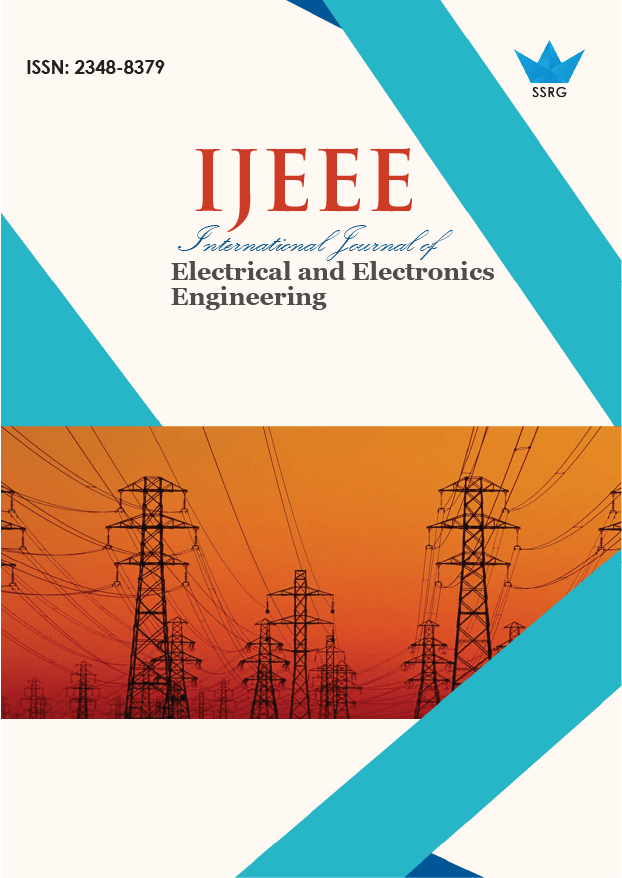GTEM Cell-Based Immunity and Emission Test for Multi-Frequency Applications

| International Journal of Electrical and Electronics Engineering |
| © 2025 by SSRG - IJEEE Journal |
| Volume 12 Issue 9 |
| Year of Publication : 2025 |
| Authors : Hetal M Pathak, Maharshi M Pathak, Shweta N Shah |
How to Cite?
Hetal M Pathak, Maharshi M Pathak, Shweta N Shah, "GTEM Cell-Based Immunity and Emission Test for Multi-Frequency Applications," SSRG International Journal of Electrical and Electronics Engineering, vol. 12, no. 9, pp. 178-181, 2025. Crossref, https://doi.org/10.14445/23488379/IJEEE-V12I9P118
Abstract:
In the modern communication world, all are connected with other members of the world through communication devices. The Gigahertz Transverse Electromagnetic (GTEM) cell is a versatile equipment for the measurement of conducting Electromagnetic Compatibility (EMC) with both emission and immunity testing in a free field environment. This paper mostly presents an analysis of GTEM-based testing for multi-frequency applications. The achieved results emphasized the GTEM cell performance to simulate electromagnetic conditions for various electronic devices. All these Electromagnetic emission devices are tested for compatibility prior to trade on the market. In this paper, the immunity and emission tests of different helical antennas and a wideband antenna at various frequencies are tested using a fabricated optimized GTEM cell. The fabricated optimized GTEM cell is validated for multi-frequency immunity, emission test using several helical microstrip and octagonal antennas. The developed antennas at various frequencies, 490 MHz, 800 MHz, and 2.4 GHz, are tested to validate the optimized GTEM cell.
Keywords:
Antennas, Septum, Immunity Test, Electromagnetic Compatibility, GTEM.
References:
[1] John D. Kraus, Antennas and Wave Propagation, 4th ed., Tata McGraw Hill Education, New Delhi, 2010.
[Google Scholar]
[2] A.N Jaafar et al., “Analysis of Helical Antenna for Wireless Application at 2.4 GHz,” 2019 IEEE Asia-Pacific Conference on Applied Electromagnetics (APACE), Melacca, Malaysia, pp. 1-5, 2019.
[CrossRef] [Google Scholar] [Publisher Link]
[3] Xueli Liu et al., “An Origami Reconfigurable Axial-Mode Bifilar Helical Antenna,” IEEE Transactions on Antennas and Propagation, vol. 63, no. 12, pp. 5897-5903, 2015.
[CrossRef] [Google Scholar] [Publisher Link]
[4] K. Jimisha, and Santhosh Kumar, “Optimum Design of Exponentially Varying Helical Antenna with Non-Uniform Pitch Profile,” Procedia Technology, vol. 6, pp. 792-798, 2012.
[CrossRef] [Google Scholar] [Publisher Link]
[5] Jiawen Nie et al., “The Effect of 2.45 GHz Electromagnetic Interference on a Microcontroller IC,” 2017 Progress in Electromagnetics Research Symposium-Fall (PIERS-FALL), Singapore, pp. 2689-2694, 2017.
[CrossRef] [Google Scholar] [Publisher Link]
[6] M.Y. Zeain et al., “Design of Helical Antenna for next Generation Wireless Communication,” Electrotechnical Review, vol. 96, no. 11, pp. 96-99, 2020.
[CrossRef] [Google Scholar] [Publisher Link]

 10.14445/23488379/IJEEE-V12I9P118
10.14445/23488379/IJEEE-V12I9P118